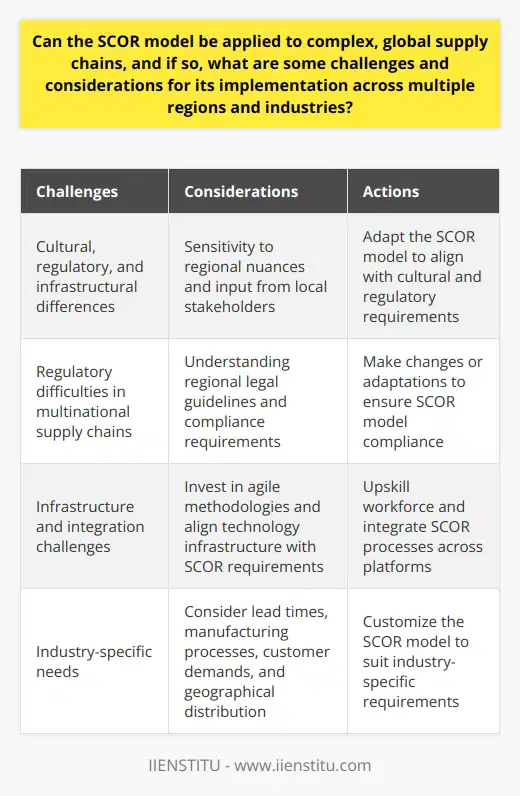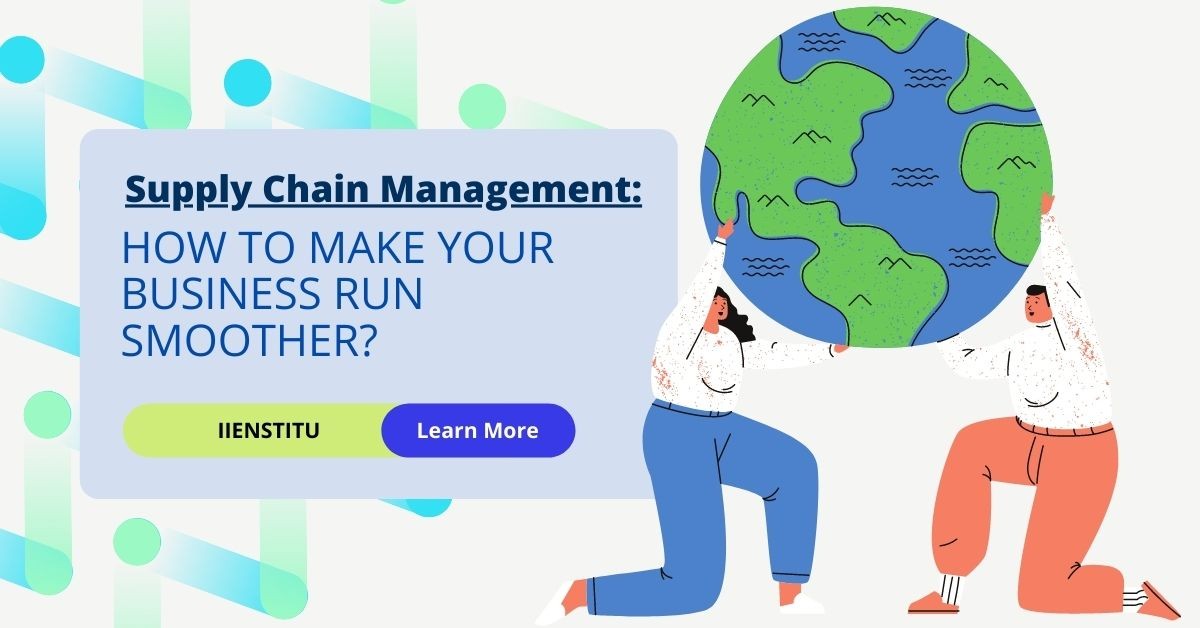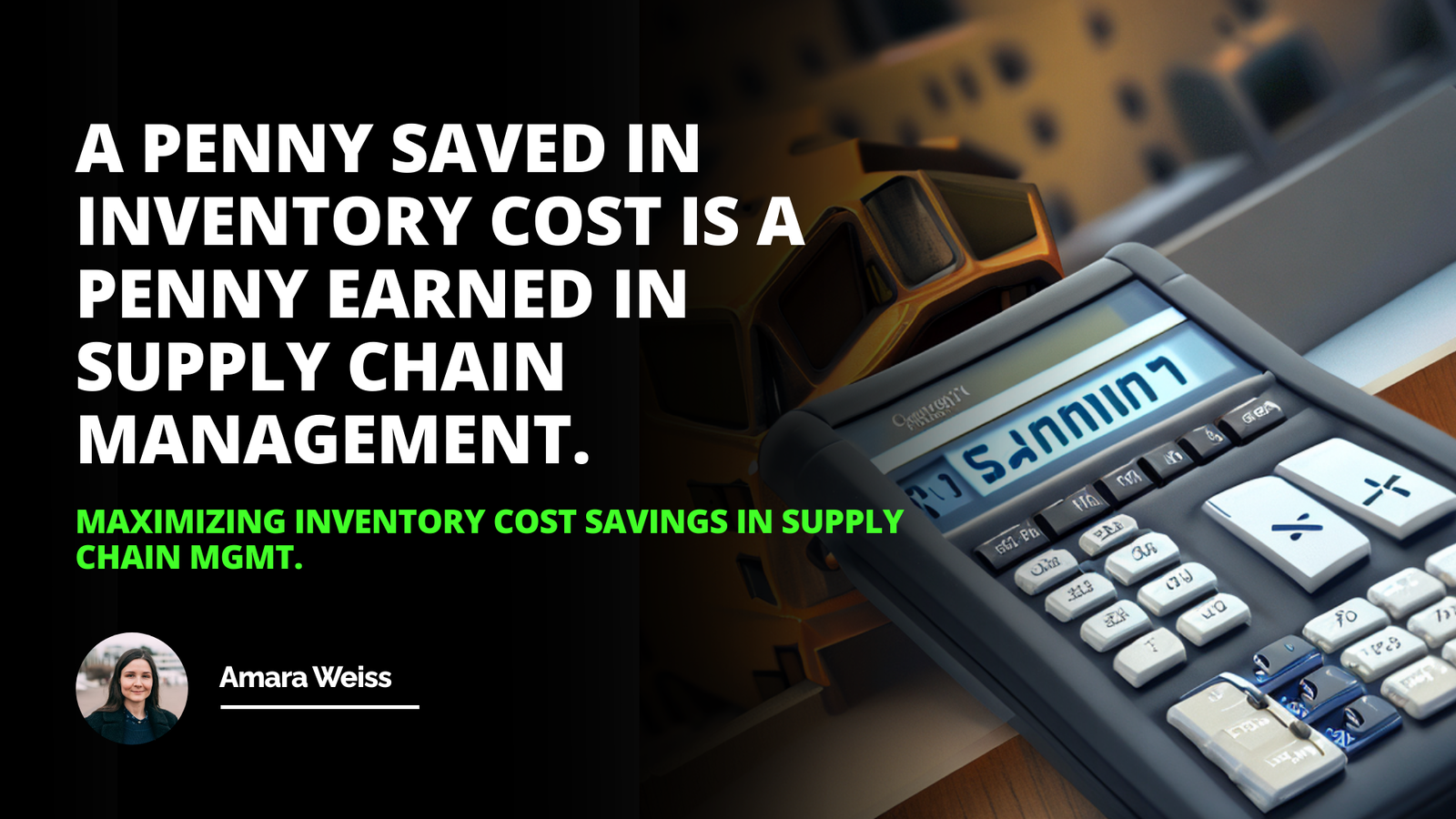
The SCOR Model is a comprehensive framework developed by the Supply Chain Council to provide a comprehensive view of the end-to-end supply chain. It maps the processes in any supply chain, from planning and sourcing of materials to delivery and return of products. The SCOR Model is a valuable tool for companies to analyze and optimize their supply chain operations. It includes six top-level processes, the core activities related to creating and delivering value to a customer.
These six processes are plan, source, make, deliver, return, and enable. Each process contains many levels of sub-processes, which are referred to as process groups. The SCOR Model also provides a common language for supply chain professionals, which helps to facilitate communication and collaboration.
Introduction
What is the SCOR Model?
Benefits of SCOR Model
Six Process Groups of SCOR Model
Conclusion
Introduction
The Supply Chain Operations Reference (SCOR) Model is a comprehensive framework that provides a comprehensive view of the end-to-end supply chain. It is a tool used to map the processes in any supply chain, from the planning and sourcing of materials to the delivery and return of products. The SCOR Model is a valuable tool for companies to analyze and optimize their supply chain operations.
What is the SCOR Model?
The SCOR Model was developed by the Supply Chain Council (SCC) in 1996 to standardize supply chain operations. The SCC is a non-profit organization dedicated to helping companies improve their supply chain performance. The SCOR Model is a framework used to identify and document the processes in a supply chain. It includes six top-level processes, the core activities related to creating and delivering value to a customer. These six processes are plan, source, make, deliver, return, and enable.
Benefits of the SCOR Model
The SCOR Model provides a comprehensive view of the supply chain, which allows companies to identify and analyze processes to improve their operations. The SCOR Model also provides a common language for supply chain professionals, which helps to facilitate communication and collaboration. Furthermore, the SCOR Model can benchmark performance against other companies, allowing companies to identify areas of improvement.
Six Process Groups of the SCOR Model
The SCOR Model consists of six top-level processes, which are the core activities related to creating and delivering value to a customer. These six processes are plan, source, make, deliver, return, and enable. Each of these processes contains many levels of sub-processes, which are referred to as process groups.
The plan process group includes activities such as demand planning, supply planning, and inventory planning. The source process group includes activities such as supplier selection, supplier evaluation, and purchase order management. The make process group includes production scheduling, production control, and quality control. The delivery process group includes order fulfillment, transportation, and warehousing. The return process group includes activities such as returns management and reverse logistics. Finally, the enable process group includes IT systems, performance measurement, and process improvement activities.
Conclusion
The SCOR Model is a comprehensive framework that provides a comprehensive view of the end-to-end supply chain. It is a valuable tool for companies to analyze and optimize their supply chain operations. The SCOR Model includes six top-level processes, which are the core activities related to creating and delivering value to a customer. These six processes are plan, source, make, deliver, return, and enable. Each of these processes contains many levels of sub-processes, which are referred to as process groups. The SCOR Model is a powerful tool that can be used to identify and analyze processes to improve supply chain operations.
The SCOR Model is the key to efficient supply chain management - unlocking the potential of your business.
The SCOR Model, developed by the Supply Chain Council, offers a comprehensive view of end-to-end supply chain processes, enabling businesses to optimize their operations. Consisting of six critical activities - planning, sourcing, producing, delivering, returning, and enabling - it identifies and catalogs the various process groups within each function. This model serves as a common language for supply chain professionals, fostering better communication and collaboration. Furthermore, it allows for performance benchmarking against other firms, identifying areas for improvement. Individuals armed with a certificate in logistics and supply chain management can effectively use such tools like the SCOR Model to drive efficiency and profitability in an organization's supply chain functions.
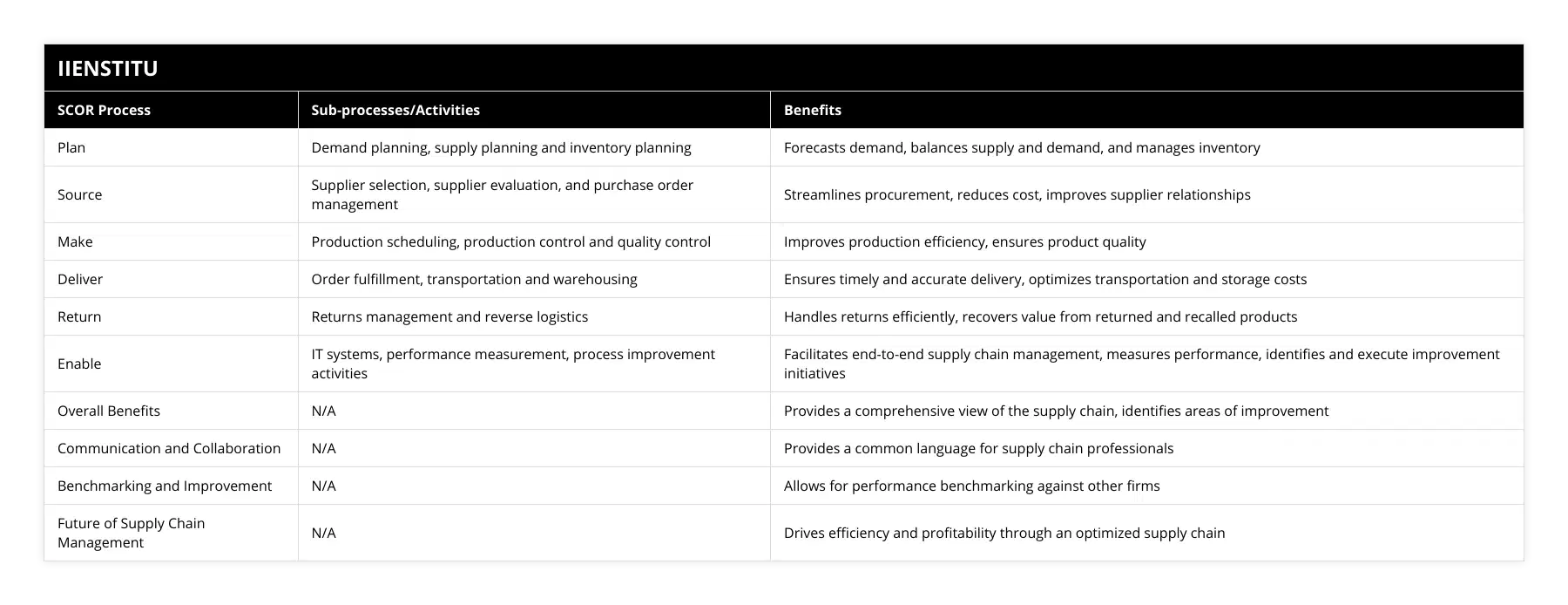
Frequently Asked Questions
What are the six process groups of the SCOR Model?
The Supply-Chain Operations Reference (SCOR) Model is an industry-standard tool used to optimize business processes and improve supply chain performance. Its six process groups – Plan, Source, Make, Deliver, Return, and Enable – provide a framework for understanding and managing the end-to-end supply chain. This article will discuss the purpose and function of each process group within the SCOR Model.
The Plan process group is concerned with setting goals and objectives for the supply chain, such as determining customer demand and establishing inventory levels. It includes demand and supply planning, service level management, and performance measurement.
The Source process group is concerned with purchasing and managing materials and services from external and internal sources. It includes supplier selection and evaluation, contract negotiation, and performance management.
The Make process group is concerned with transforming raw materials into finished goods and services. It includes process design and scheduling, capacity planning, and process control.
The Deliver process group is concerned with moving products and services from the source to the customer. It includes order processing, inventory management, transportation management, and warehousing.
The Return process group is concerned with returning products and services to the source. It includes reverse logistics, return materials authorization, and quality control.
Finally, the Enable process group is concerned with providing the necessary infrastructure for the other five process groups. It includes information management, financial management, and service management.
In conclusion, the SCOR Model provides a comprehensive framework for understanding and managing the end-to-end supply chain. Its six process groups – Plan, Source, Make, Deliver, Return, and Enable – provide a means of structuring and optimizing business processes.

What are the benefits of using the SCOR Model in supply chain management?
The Supply Chain Operations Reference (SCOR) model is designed to help organizations assess, measure, and improve their supply chain processes. It is used to evaluate the performance of a company's supply chain and provide insights into areas that need improvement. The model provides a comprehensive view of the supply chain and can track performance over time. This article will explore the benefits of using the SCOR model in supply chain management.
One of the key benefits of using the SCOR model is the ability to measure supply chain performance. The model provides a comprehensive view of the entire supply chain process, from sourcing to delivery. It also tracks performance metrics such as cost, quality, and delivery time. This allows companies to identify areas that need improvement and develop strategies to improve those areas.
Another benefit of the SCOR model is its ability to provide visibility into the supply chain. The model provides a holistic view of the entire supply chain and the ability to identify areas of inefficiency. This enables companies to identify bottlenecks and develop strategies to improve performance.
The SCOR model also provides a framework for collaboration between different stakeholders in the supply chain. The model enables companies to develop strategies and procedures that all stakeholders can agree on. This helps to ensure that all stakeholders are on the same page and working towards a common goal.
Finally, the SCOR model allows for the developing of effective supply chain strategies. The model provides a platform for companies to develop a comprehensive strategy that considers all aspects of the supply chain. This helps ensure that all stakeholders work together to develop an effective supply chain strategy.
In conclusion, the SCOR model provides a framework for assessing, measuring, and improving supply chain performance. It provides a comprehensive view of the entire supply chain and the ability to track performance metrics. It also provides a platform for collaboration between different stakeholders and enables the development of effective supply chain strategies. By taking advantage of the SCOR model, companies can ensure that their supply chains are operating at peak efficiency.

How does the SCOR Model help to unlock supply chain management?
Supply chain management is a complex process that requires a comprehensive understanding of the entire supply chain network and its components. The Supply Chain Operations Reference (SCOR) model is a comprehensive, standardized framework for understanding, analyzing, and measuring supply chain performance. It is a tool that helps organizations to identify and analyze their supply chain operations in order to optimize them and unlock the potential of their supply chain.
The SCOR model helps to provide a holistic view of the supply chain by providing a common language and metrics for measuring and comparing supply chain performance. It provides a clear and structured way to measure, analyze and improve supply chain performance. The SCOR model is comprised of five main elements: plan, source, make, deliver and return. Each of these elements are further broken down into sub-elements, which provide a comprehensive view of the supply chain.
The SCOR model helps to identify opportunities for improvement by providing a framework to compare actual performance with planned performance. It also helps to identify sources of inefficiency and to develop strategies for improvement. The model provides a systematic approach for measuring, analyzing and benchmarking supply chain performance.
The SCOR model also helps to identify areas where collaboration and coordination across different parts of the supply chain can lead to better performance. It helps to identify opportunities for improvement through the integration of processes, resources and information across the supply chain. By using the SCOR model, organizations can develop strategies to optimize the use of resources, reduce costs and improve supply chain performance.
Finally, the SCOR model helps to unlock the potential of the supply chain by providing a framework for understanding, planning, analyzing and measuring supply chain performance. It helps to identify opportunities for improvement and provide a roadmap for improvement. By using the SCOR model, organizations can unlock the potential of their supply chain and achieve greater efficiency, productivity and profitability.
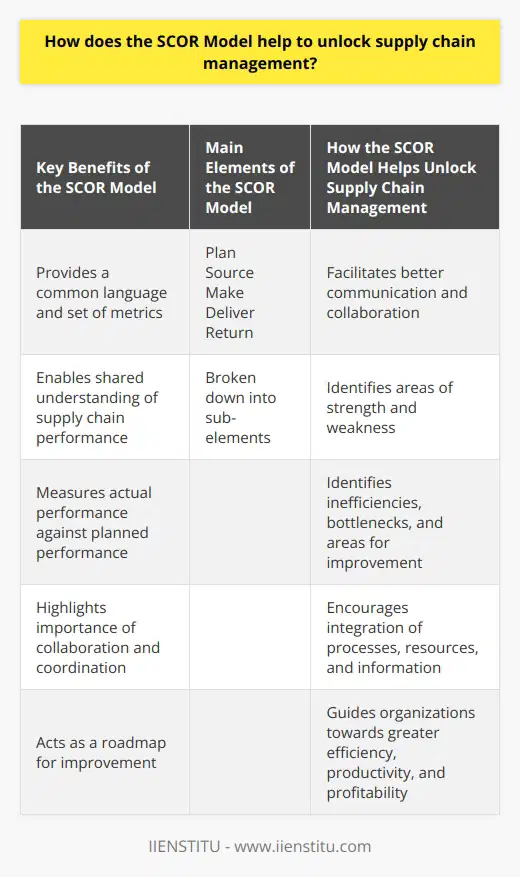
What is the relationship between the SCOR model and the overall strategy of a supply chain?
The SCOR Model's Role in Supply Chain Strategy
The Supply Chain Operations Reference (SCOR) model serves as a crucial framework for developing and adjusting supply chain strategy. Establishing a symbiotic relationship with the overall strategy, SCOR drives optimization and enhances competitive advantage. By applying this holistic approach, organizations can link operational processes to strategic goals, leading to improved performance and outcomes.
Key Components of the SCOR Model
The SCOR model consists of five primary management processes: plan, source, make, deliver, and return. These interconnected processes allow organizations to assess their supply chain efficiency, identify areas for improvement, and facilitate communication between supply chain partners.
Aligning SCOR with Strategic Goals
The SCOR model provides a systematic approach to achieving strategic alignment across the supply chain. It guides organizations in identifying performance gaps, setting realistic targets, and determining required resources. By aligning SCOR processes with the organization's overall strategy, supply chain partners can collaboratively work toward shared objectives.
Enhancing Competitive Advantage
Incorporating the SCOR model into the supply chain strategy ensures the continuous pursuit of a competitive advantage. The model's focus on best practices and benchmarking allows organizations to streamline operations, reduce costs, and improve service levels. As a result, they become more agile, responsive, and able to meet customer demands.
Enabling Adaptation and Innovation
The constantly evolving nature of supply chains necessitates the adoption of flexible and adaptable strategies. The SCOR model supports this need by providing a framework for organizations to innovate, adapt, and respond to changing market conditions. By leveraging the insights gained through SCOR adoption, management can make informed decisions to create a more resilient supply chain.
Conclusion
In summary, the relationship between the SCOR model and the overall strategy of a supply chain is mutually beneficial, with the SCOR model playing a fundamental role in driving strategic alignment and achieving desired outcomes. By incorporating the SCOR model into supply chain strategy, organizations can optimize their operations, enhance their competitive advantage, and foster innovation and adaptability. Ultimately, the application of the SCOR model contributes to a more effective and responsive supply chain, positioning an organization for long-term success.

How can the SCOR methodology be used to optimize a company's supply chain performance?
Understanding SCOR Methodology
The Supply Chain Operations Reference (SCOR) methodology is a process-oriented framework designed to evaluate, diagnose, and improve a company's supply chain performance. By identifying key performance indicators (KPIs) and adopting industry best practices, the SCOR methodology fosters collaboration and efficiency within a supply chain ecosystem and drives optimal results.
Implementing SCOR Principles
To optimize a company's supply chain performance, the SCOR methodology relies on five fundamental principles: plan, source, make, deliver, and return. These principles are interconnected and provide a strategic approach to assessing and improving supply chain processes.
Plan: This step involves setting supply chain objectives and establishing a robust planning process to ensure alignment with overall business goals. Fostering communication and visibility throughout the supply chain is essential for effective planning.
Source: Optimizing sourcing entails identifying suitable suppliers, negotiating contracts, and managing supplier relationships to ensure quality, cost-effectiveness, and on-time delivery of goods and services. A transparent procurement process is crucial to achieving this objective.
Make: This principle focuses on implementing efficient production processes that deliver consistent, high-quality products to customers. Emphasizing lean manufacturing techniques and continuous improvement can drive process optimization in this area.
Deliver: The delivery stage is all about ensuring timely and cost-effective transportation and distribution of finished goods. Implementing advanced logistics management systems and fostering collaboration with key stakeholders can improve delivery performance.
Return: The return principle addresses the need for an integrated process to handle product returns, reverse logistics, and recycling. Effective reverse supply chain management is critical to minimizing costs and environmental impacts associated with returned products.
Leveraging SCOR Metrics
In addition to the five principles, the SCOR methodology emphasizes the importance of monitoring and managing relevant metrics to evaluate supply chain performance. By categorizing metrics into three main areas - reliability, responsiveness, and cost - SCOR provides a comprehensive yet focused approach to performance management.
Moreover, SCOR encourages benchmarking against industry standards and competitors to identify areas of improvement and best practices that can be adopted within the organization. The competitive advantage gained from this continuous improvement mindset can significantly enhance a company's supply chain performance.
In conclusion, the SCOR methodology offers a valuable framework to assess, diagnose, and improve a company's supply chain performance. By adopting its principles, leveraging its metrics, and embracing a culture of continuous improvement, organizations can optimize their supply chain processes and drive superior business results.
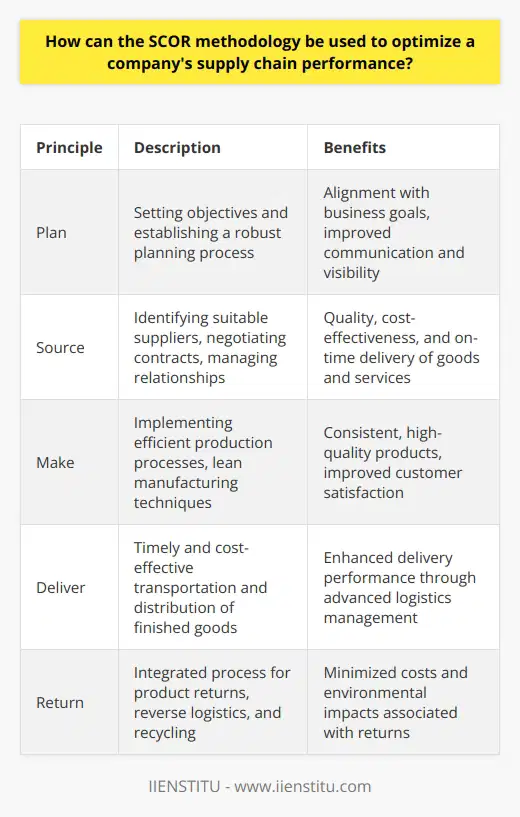
What are the key components of the SCOR model and how do they interact with one another within a supply chain?
Supply Chain Operations Reference (SCOR) Model
**Overview of SCOR Model Components**
The Supply Chain Operations Reference (SCOR) model is a framework that helps organizations evaluate and optimize their supply chain performance. It consists of four key components, namely Plan, Source, Make, and Deliver. These components are critical in achieving an efficient and effective supply chain management system, as they interact with one another to support the overall process.
**Plan Component**
The Plan component encompasses the development of strategies and tactics needed to balance supply and demand in a supply chain. This includes demand forecasting, inventory management, and capacity planning. Effective planning facilitates better coordination among other SCOR components, ensuring optimal utilization of resources and maximization of customer satisfaction.
**Source Component**
The Source component involves identifying, selecting, and managing suppliers that provide the necessary products, services, or raw materials for the supply chain. This component focuses on building strong supplier relationships, negotiating contracts, and monitoring supplier performance. It is crucial as it interacts with other components in determining the quality, cost, and lead time of products flowing through the supply chain.
**Make Component**
The Make component concerns the transformation of raw materials or components into finished goods or services. This involves manufacturing, assembly, and quality control processes. The Make component interacts closely with the Source and Deliver components to ensure that raw materials are available and finished goods are distributed promptly to fulfill customer demands.
**Deliver Component**
The Deliver component entails transporting and distributing products or services to customers. This involves logistics, transportation, warehousing, and order fulfillment processes. The Deliver component's effectiveness directly impacts customer satisfaction, as it must accommodate varying customer requirements and delivery schedules. It interacts with the Plan, Source, and Make components to ensure that products are delivered in the right quantities, at the right time, and to the right locations.
**Interaction among SCOR Components**
The SCOR model's components interact with one another by complementing their individual functions to achieve an efficient, well-coordinated supply chain. For example, the Plan component supports the Source and Make components by providing them with accurate forecasts of customer demand, enabling better allocation of resources. Simultaneously, the Deliver component relies on the outputs of the Plan, Source, and Make components to ensure timely and accurate distribution of products and services.
In conclusion, the SCOR model's Plan, Source, Make, and Deliver components are integral to supply chain management as they interact to optimize performance and enhance customer satisfaction. Understanding the roles and interdependencies of these components allows organizations to design, implement, and manage an effective and efficient supply chain system.
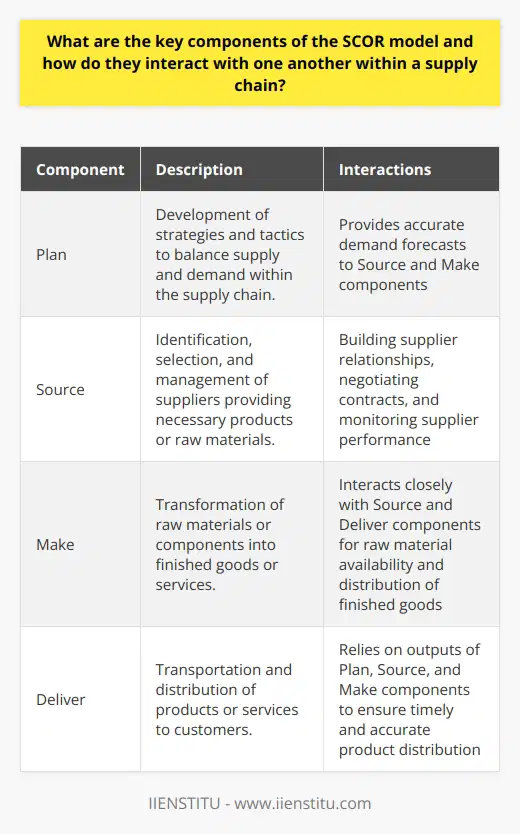
What is the significance of the Supply Chain Council in the development and implementation of the SCOR methodology?
Significance of the Supply Chain Council
The Supply Chain Council (SCC) is an organization that played an essential role in the development and implementation of the Supply Chain Operations Reference (SCOR) methodology, which has significantly impacted modern supply chain management.
Establishment of the SCOR Framework
SCC, founded in 1996, brought together supply chain leaders from prominent organizations to address vital challenges in supply chain management. These professionals collaborated to establish the SCOR framework, a comprehensive model that defined, measured, analyzed, and improved supply chain processes.
Standardization in Supply Chain Management
One of the main contributions of SCC to the SCOR methodology is its standardization of various supply chain processes. SCC provided universal definitions for key terms and concepts, enabling supply chain stakeholders to communicate effectively and coordinate activities. This common language facilitated collaboration and minimized confusion, contributing to improved operational performance.
Benchmarking and Best Practices
SCC not only facilitated the development of standardized processes but also established benchmarking practices for supply chain performance. By collecting and analyzing data from participating organizations, SCC identified best practices and gave companies the opportunity to compare their performance against established standards. This benchmarking approach enabled continuous improvement and fostered an environment of healthy competition, driving process efficiencies across entire industries.
Dissemination and Training
SCC played a crucial role in the dissemination of the SCOR methodology by providing training sessions and certifying professionals in SCOR Project Management. This widespread adoption of the SCOR model resulted from the council's efforts, thereby promoting the effective management of supply chains in various industries globally.
Ongoing Development and Support
As a significant player in the development of the SCOR methodology, SCC continues to support and enhance the model. In 2014, SCC merged with the American Production and Inventory Control Society (APICS) to form the Association for Supply Chain Management (ASCM), an organization committed to further developing SCOR and supporting supply chain professionals worldwide.
In conclusion, the Supply Chain Council has been instrumental in the development, implementation, and ongoing support of the SCOR methodology. Its efforts in standardization, benchmarking, and training have significantly contributed to the advancement of supply chain management practices in numerous industries worldwide.

How can organizations adapt and customize the SCOR model to suit their unique supply chain requirements and objectives?
Understanding the SCOR Model
The Supply Chain Operations Reference (SCOR) model provides an industry-standard method for assessing and improving supply chain performance. Created by the Supply Chain Council, this framework enables organizations to understand their own supply chains, identify areas for improvement, and measure their success against industry benchmarks.
Customization and Adaptation
To tailor the SCOR model to their unique requirements and objectives, organizations must first assess their supply chain operations and identify the critical components for their specific industry, product, or service. This requires studying the supply network structure, from sourcing to delivery, and determining key performance indicators (KPIs) relevant to the company's strategic goals.
Incorporating Process Elements
Organizations should consider incorporating the process elements relevant to their supply chain context, such as manufacturing, transportation, or inventory management. By integrating these specific processes into the SCOR model, companies can ensure that the framework aligns with their operational realities and supports the achievement of their performance objectives.
Benchmarking Performance
As part of the customization process, organizations should also identify appropriate benchmarks to measure their supply chain performance. Benchmarking against industry standards or comparable peers provides a valuable reference point that helps to evaluate the efficacy of their supply chain strategies and uncover potential areas for improvement.
Implementing Continuous Improvement
To maximize the benefits of the SCOR model, organizations should incorporate continuous improvement initiatives in their supply chain strategies. This involves regularly revisiting and refining the customized SCOR model based on feedback loops and metrics analysis. Continuous improvement helps companies adapt to evolving market conditions, maintain a competitive edge, and drive growth.
Conclusion
Organizations can leverage the SCOR model's adaptability by customizing it to suit their unique supply chain operations and objectives. This involves mapping the company's supply chain processes, identifying KPIs, and selecting suitable benchmark comparisons. By implementing a tailored SCOR model, companies can enhance the effectiveness of their supply chain strategies and attain their performance goals.
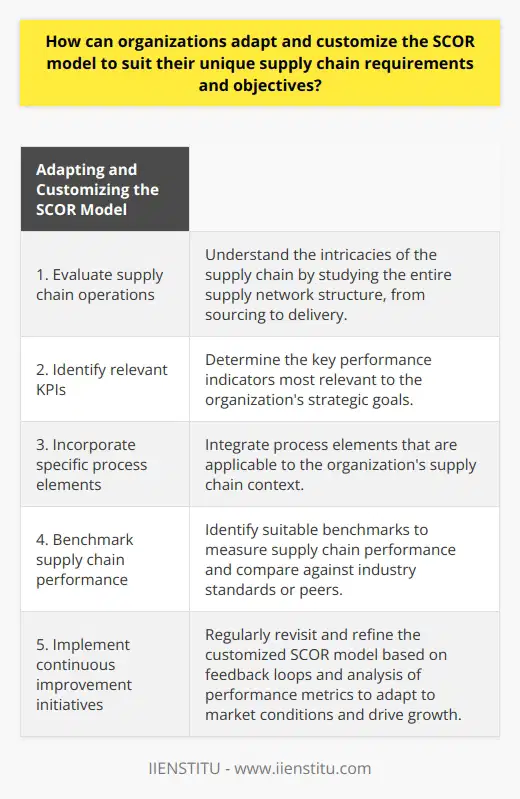
In what ways does the application of the SCOR model contribute to sustainable and environmentally friendly supply chain practices?
SCOR Model and Sustainability
The SCOR (Supply Chain Operations Reference) model provides a framework for analyzing, designing, and implementing sustainable and environmentally friendly supply chain practices. Specifically, the SCOR model contributes to these practices in several ways.
Enhancing Environmental Performance
First, the SCOR model fosters environmental performance by setting measurable objectives, promoting the efficient use of resources, and reducing waste. By benchmarking best practices and performance indicators, organizations can target areas of improvement and set goals for achieving environmental excellence.
Optimizing Resource Utilization
Second, the SCOR model enables companies to optimize their resource utilization by identifying areas of over-consumption and inefficiencies within the supply chain. By analyzing the process performance, companies can adopt more sustainable practices that minimize waste, reduce emissions, and conserve natural resources.
Promoting Collaboration and Integration
Third, the SCOR model encourages collaboration and integration among supply chain partners. By aligning strategic objectives and sharing environmental goals, organizations can collectively work toward achieving more sustainable and eco-friendly supply chain practices. This collaborative approach facilitates the exchange of ideas, knowledge, and innovations that contribute to environmental sustainability.
Supporting Eco-Innovations
Fourth, the SCOR model supports the development and implementation of eco-innovations. These innovations can involve designing greener products, promoting recycling and reuse, and improving energy efficiency throughout the supply chain. Emphasizing eco-innovations as strategic objectives allows organizations to remain competitive while minimizing their environmental impact.
Monitoring Environmental Compliance
Lastly, the SCOR model facilitates monitoring of environmental compliance by establishing guidelines and standards for supply chain operations. By adhering to these standards, companies can ensure that they are following the most environmentally responsible practices and avoiding potential legal or regulatory consequences.
In conclusion, the application of the SCOR model contributes decisively to sustainable and environmentally friendly supply chain practices through improving environmental performance, optimizing resource utilization, promoting collaboration, supporting eco-innovations, and monitoring compliance. By implementing the SCOR model, organizations can pave the way for a greener and more sustainable future in their supply chain operations.
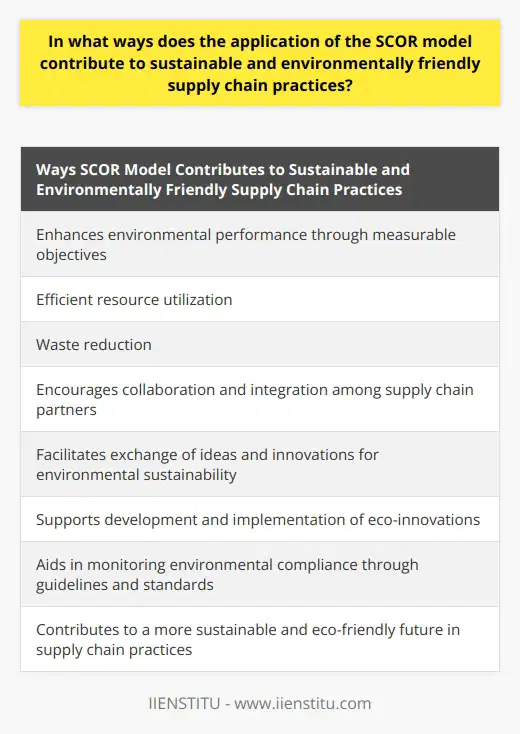
What is the SCOR model in supply chain management and how does it differ from other supply chain management methodologies?
Introduction to the SCOR Model
The Supply Chain Operations Reference (SCOR) model is a business process framework that focuses on improving supply chain operations. Developed by the Supply Chain Council (now part of APICS), the SCOR model integrates business processes, metrics, best practices, and technology features, resulting in a comprehensive approach to managing supply chains. The model's primary objective is to enhance the efficiency, agility, and responsiveness of supply chain processes.
Key Components of the SCOR Model
The SCOR model comprises five management processes: plan, source, make, deliver, and return. These components enable businesses to streamline their supply chain operations and evaluate performance using standardized metrics. Additionally, the SCOR model encompasses three performance levels: strategic, tactical, and operational, which facilitate the development of supply chain strategies and tactics that align with broader organizational goals.
Differentiation from Other Methodologies
Unlike other supply chain management methodologies, the SCOR model emphasizes an end-to-end approach. By covering all aspects of the supply chain, from suppliers to customers, the model ensures the optimization of overall performance instead of focusing on individual process improvements. Furthermore, the SCOR model transcends industries and sectors, making it applicable to a wide range of businesses.
The standardized system of metrics provided by the SCOR model is another differentiating factor. By offering a consistent set of performance indicators, the model facilitates benchmarking and comparison against industry best practices. This allows organizations to identify gaps and areas of improvement, driving continuous innovation in supply chain processes.
Final Thoughts
In conclusion, the SCOR model is a holistic approach to supply chain management that encompasses planning, sourcing, manufacturing, delivering, and returning processes. Its comprehensive nature sets it apart from other methodologies, as it emphasizes the importance of optimizing the entire supply chain rather than individual processes. Additionally, the standardized metrics within the SCOR model enable businesses to benchmark their performance against industry best practices, thereby fostering continuous improvement and innovation in supply chain operations.

How do you implement a SCOR model in an organization and what are the critical success factors for its effective execution?
Implementing a SCOR Model in an Organization
To implement a Supply Chain Operations Reference (SCOR) model in an organization, it is crucial to follow a structured approach. This involves understanding the organization's supply chain needs, reviewing existing processes, evaluating performance indicators, and identifying areas for improvement.
Identifying Supply Chain Needs
Start by comprehending the supply chain requirements of the organization. This includes understanding the company's supply chain management (SCM) objectives, analyzing the industry landscape, and assessing competitor supply chains to identify best practices that can be adopted.
Examining Existing Processes
Next, review the organization's existing supply chain processes, taking into account product flows, information exchange mechanisms, and working relationships with suppliers and customers. This analysis will enable the identification of inefficiencies and areas of high cost, which can be improved through SCOR implementation.
Establishing Performance Indicators
After understanding the current state of the supply chain, develop a set of Key Performance Indicators (KPIs) to benchmark the SCOR model's efficacy. These metrics will aid in the tracking of progress and measuring the success of SCOR implementation. KPIs should focus on aspects like order fulfillment, inventory accuracy, and supplier performance.
Designing the SCOR Model
Using the gathered information and research, develop an optimal SCOR model aligned with the organization's SCM objectives. The model should include a combination of best practices, specific process improvements, and technologies to address identified process inefficiencies in the supply chain.
Executing the SCOR Model
Once the model is designed, execute it across the organization. This will require training employees on the new processes, instituting the necessary technologies, and monitoring adjustments during the transition phase. Leading change management practices should be employed to ensure a smooth transformation.
Maintaining Continuous Improvement
Finally, organizations must maintain a culture of continuous improvement. This involves regularly monitoring performance indicators, reassessing the SCOR model to capture new opportunities, and refining processes and practices to stay competitive in the market.
Critical success factors in executing an effective SCOR model include top management support, employee involvement, effective change management, a comprehensive understanding of supply chain operations, and continuous performance tracking. By adhering to these factors, organizations can successfully implement a SCOR model and realize the benefits of improved supply chain efficiency, reduced costs, and enhanced customer satisfaction.

What is the impact of the SCOR model on the operational efficiency, cost reduction, and overall competitiveness of a supply chain?
Operational Efficiency Enhancement
The SCOR model significantly enhances operational efficiency within a supply chain by providing a standardized framework for evaluating, measuring, and optimizing various processes. This framework enables organizations to identify areas of inefficiency, prioritize improvement initiatives, and streamline workflows, leading to greater productivity and higher service levels.
Cost Reduction Opportunities
Moreover, the SCOR model supports cost reduction efforts by offering a comprehensive, cross-functional perspective on the supply chain. Through the use of benchmarking and best practices identification, companies can swiftly detect inefficiencies and redundancies in their operations. By addressing these issues, organizations can achieve tangible cost savings, which can be reinvested in strategies to drive further value and improve competitiveness.
Competitiveness Enhancement
In addition to improving efficiency and reducing costs, the SCOR model is an invaluable tool for bolstering a supply chain's overall competitiveness. As global markets continue to evolve and customer expectations rise, having an adaptable and resilient supply chain is crucial. Using the SCOR model to assess and adjust key performance indicators, companies can better align their supply chain capabilities with their strategic objectives, enabling them to outperform competitors and establish a lasting competitive advantage.
In conclusion, the impact of the SCOR model on a supply chain is multifaceted, with positive effects on operational efficiency, cost reduction, and overall competitiveness. By adopting this robust and widely-accepted framework, organizations can uncover valuable insights and opportunities to improve their end-to-end supply chain performance, ultimately delivering superior value to their customers and stakeholders.
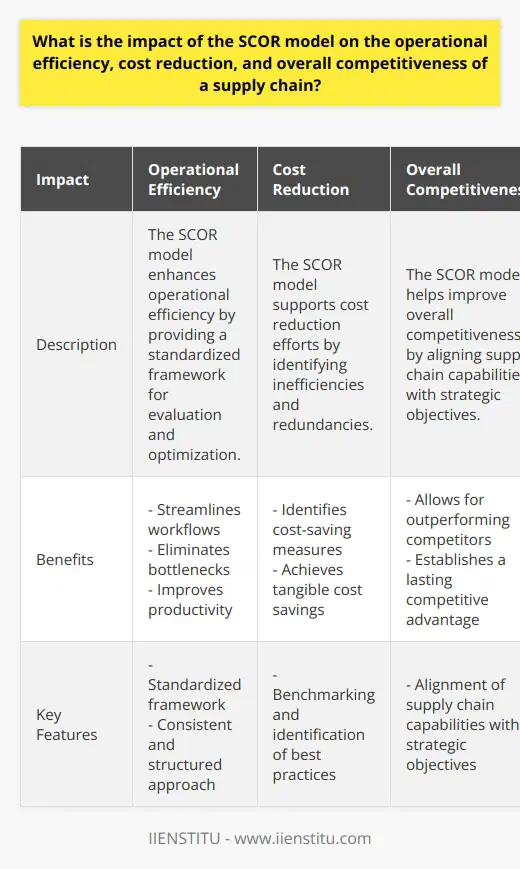
What is the SCOR model of supply chain management and how does it differ from other supply chain management methodologies?
SCOR Model Overview
The Supply Chain Operations Reference (SCOR) model is a comprehensive framework for evaluating, improving, and optimizing a company's supply chain processes. Developed by the Supply Chain Council (now part of APICS), the SCOR model provides a standardized approach to assess supply chain performance, identify inefficiencies, and implement best practices. It encompasses all activities from procurement to the delivery of finished goods, and includes five primary management processes: Plan, Source, Make, Deliver, and Return.
Distinct Features of SCOR
What differentiates the SCOR model from other supply chain management methodologies is its holistic approach and focus on cross-functional processes. It captures the entire scope of supply chain activities by integrating various functions, including supply chain strategy, material flow, information systems, and financial management. This helps organizations identify bottlenecks and inefficiencies in their operations and provides a roadmap for improvement across the entire supply chain.
Benchmarking and Performance Measurement
Another key aspect of the SCOR model is its use of standardized metrics and benchmarks, allowing companies to measure their supply chain performance against industry best practices. Through a comprehensive set of performance indicators, the SCOR model enables organizations to evaluate their supply chain efficiency, effectiveness, agility, and asset utilization. By comparing these metrics with other companies and industry standards, organizations can identify areas for improvement and track progress over time.
Customization and Flexibility
The SCOR model is designed to be highly customizable and can be adapted to fit the specific context and priorities of any organization. Its flexibility allows companies to tailor the model to their unique business requirements, focusing on the most relevant aspects of their operations. The model encourages continuous improvement by providing a structured approach to identifying and prioritizing improvement initiatives based on their potential impact on supply chain performance.
In conclusion, the SCOR model is a valuable tool for organizations seeking to enhance their supply chain management practices. It offers a comprehensive, integrated, and flexible approach that differentiates it from other methodologies. By providing standardized metrics and benchmarks, the SCOR model allows companies to gauge their performance against best practices, identify areas for improvement, and track progress over time. Its adaptability makes it a powerful management tool for optimizing supply chain operations in a variety of industries and business contexts.
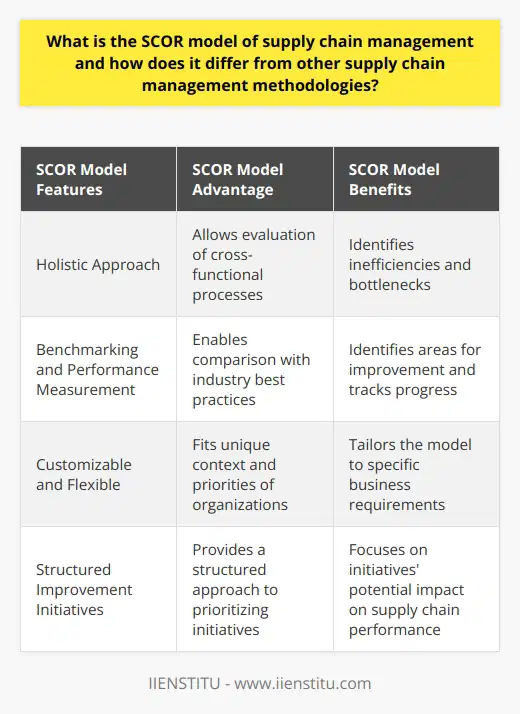
How does the SCOR Model help organizations identify and address potential inefficiencies or bottlenecks in their supply chain processes?
SCOR Model: Identifying Inefficiencies and Bottlenecks
The SCOR (Supply Chain Operations Reference) Model is valuable for organizations seeking to identify and address inefficiencies or bottlenecks in their supply chain. Developed by the Supply Chain Council, this framework involves five key processes: Plan, Source, Make, Deliver, and Return (Poirier & McCollum, 1996). By using the SCOR Model, organizations can systematically evaluate their supply chain operations, pinpoint areas for improvement, and make data-driven decisions to optimize efficiency.
Process Mapping and Benchmarking
One step of implementing the SCOR Model is process mapping, which requires organizations to create detailed visualizations of their current supply chain processes. This representation helps businesses recognize inefficiencies and bottlenecks that may require attention. Furthermore, organizations can employ benchmarking by comparing their processes to industry standards. This practice allows them to identify gaps, set performance targets, and design targeted improvements.
Performance Measurements and Continuous Improvement
The SCOR Model also includes a comprehensive set of performance measurements to track and monitor the effectiveness of supply chain processes. By applying these metrics, organizations gain essential insights into areas with suboptimal performance. This information enables them to make informed decisions about where to focus their efforts and resources. Moreover, the SCOR Model emphasizes continuous improvement, which drives organizations to consistently evaluate and refine their supply chain operations.
Holistic Analysis and Cross-Functional Collaboration
The SCOR Model adopts a holistic approach to supply chain analysis, recognizing that interdependencies exist among different processes. By examining the supply chain as a whole, organizations can identify instances where inefficiencies in one area may impact the performance of another. Hence, the model encourages cross-functional collaboration, including sharing best practices and synergizing efforts across departments. This collaborative approach promotes a more efficient and resilient supply chain.
In conclusion, the SCOR Model provides organizations with a systematic and comprehensive framework for identifying and addressing potential inefficiencies or bottlenecks in their supply chain processes. By leveraging process mapping, benchmarking, performance measurements, and cross-functional collaboration, businesses can attain a high level of supply chain efficiency and optimize their operations for long-term success.
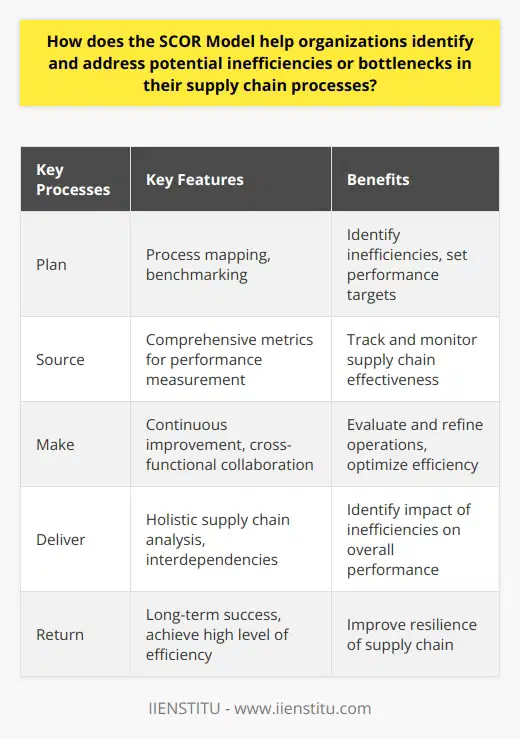
What are some best practices for implementing a SCOR model within an organization to ensure its success and achieve maximum benefits from its application?
Establish Clear Objectives and Scope
For successful implementation of the SCOR model within an organization, it is crucial to establish clear objectives and define the project scope. This involves outlining the desired outcomes, relevant processes, and functional areas targeted for improvement. By doing so, the organization can effectively prioritize efforts and maintain focus on achieving the intended benefits.
Develop a Cross-Functional Team
The formation of a cross-functional team consisting of representatives from various departments, such as supply chain, logistics, and manufacturing, is essential for implementing the SCOR model. This diverse team fosters open communication, ensures a holistic approach to problem-solving, and facilitates a broader understanding of the organization's supply chain processes.
Provide Training and Support
Investing in comprehensive training and support for the cross-functional team and other stakeholders ensures a solid understanding of the SCOR framework, its goals, and its application. This fosters buy-in from team members and helps overcome resistance to change, ultimately contributing to the success of the model's implementation.
Monitor and Evaluate Progress
Regular monitoring and evaluation of the implementation process are vital for identifying bottlenecks and areas requiring improvement. This involves setting key performance indicators (KPIs) aligned with the organization's objectives and using periodic assessments to track progress. Monitoring should also focus on the adoption of best practices and the effectiveness of the implemented strategies.
Continuously Improve Processes
The SCOR model encourages a continuous improvement mindset, emphasizing that process optimization should be an ongoing endeavor. By consistently reviewing and refining supply chain operations, organizations can adapt to changing market conditions, streamline workflows, and achieve long-term success.
Encourage Collaboration and Sharing
An organization-wide culture of collaboration, transparency, and knowledge sharing is essential for the SCOR model implementation. Encouraging active participation from all stakeholders in decision-making drives ownership and accountability, which ultimately leads to the sustained success of the model.
In conclusion, implementing the SCOR model in an organization requires a strategic approach that involves clear objective-setting, cross-functional teams, training and support, monitoring and evaluation, continuous improvement, and a culture of collaboration. Adhering to these best practices ensures maximum benefits from the application of the SCOR model and strengthens organizational competitiveness in the long run.
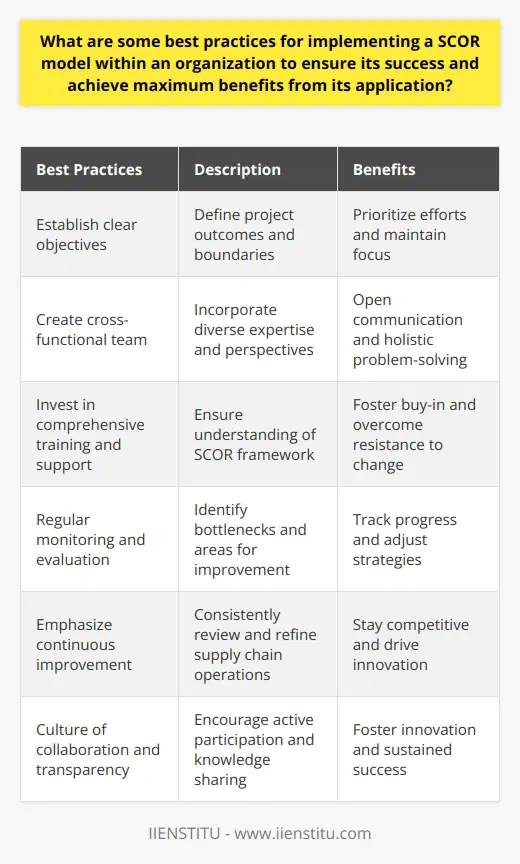
What is the role of performance metrics in the SCOR model and how do they facilitate continuous improvement in supply chain processes?
Role of Performance Metrics in SCOR Model
In the Supply Chain Operations Reference (SCOR) model, performance metrics serve as an integral component for evaluating supply chain efficiency and effectiveness. These metrics provide quantitative standards that allow supply chain stakeholders to assess performance and identify gaps or areas requiring improvement. By establishing measurable objectives and tracking progress against them, organizations can ensure streamlined operations and achieve higher levels of customer satisfaction.
Alignment with Strategic Goals
Performance metrics in the SCOR model align with organizational strategic goals and supply chain priorities, enabling organizations to focus their efforts on value-adding activities. Metrics are categorized into five primary components, namely reliability, responsiveness, agility, costs, and asset management. By monitoring these categories, companies can continuously adapt their supply chain processes to achieve desired outcomes.
Facilitating Continuous Improvement
Through the use of performance metrics, organizations can better understand their supply chain processes and isolate areas in need of focused optimization. Continuous improvement can be facilitated by systematically comparing actual results with established benchmarks, identifying discrepancies, and implementing corrective actions or targeted process enhancements. Accordingly, metrics contribute to fostering a data-driven, results-oriented organizational culture.
Benchmarking and Best Practices
The comparison of performance metrics with industry best practices and benchmarks allows organizations to gain valuable insights into their relative standing in the marketplace. This information can be utilized to drive informed decision-making for process improvement and supply chain innovation. As a result, organizations can maintain a competitive edge through sustained operational excellence and enhanced value propositions for their customers.
In conclusion, performance metrics in the SCOR model play a critical role in enabling continuous improvement within supply chain processes. By providing a standardized, quantifiable foundation for assessing performance and identifying opportunities for growth, these metrics facilitate ongoing optimization and alignment with organizational strategic objectives. Ultimately, performance measurement contributes to the overall success and competitiveness of supply chain operations, ensuring that organizations can consistently meet customer needs and expectations.

How does the SCOR model promote end-to-end visibility and collaboration among supply chain stakeholders and what are the benefits of such an approach?
SCOR Model's Role in Visibility and Collaboration
The Supply Chain Operations Reference (SCOR) model promotes end-to-end visibility and collaboration among supply chain stakeholders through its comprehensive framework, which encompasses performance management, process analysis, and best practices. By aligning diverse stakeholders on a shared model, the SCOR enables effective data exchange, better decision-making, and increased responsiveness to market demands.
Enhanced Data Exchange
One way the SCOR model facilitates visibility and collaboration is by standardizing data exchange across the supply chain. This reduces information silos, ensuring that stakeholders have access to accurate and timely data, critical for making informed decisions. The resulting transparency helps organizations identify inefficiencies, streamline operations, and reduce costs.
Informed Decision-Making
The SCOR model encourages stakeholders to collaboratively assess and optimize supply chain performance using a consistent set of metrics. This common language for measuring success, allows stakeholders to benchmark against industry standards and identify areas for improvement. Consequently, collaboration in decision-making leads to cost efficiencies, reduced lead times, and improved customer satisfaction.
Increased Responsiveness to Market Demands
The SCOR model fosters an adaptable supply chain capable of responding to changing market demands effectively. By aligning processes and sharing data among stakeholders, organizations can quickly adjust production schedules, distribution strategies, and inventory levels in response to customer needs. This agility allows supply chains to maintain a competitive edge in today's fast-paced business environment.
Benefits of an Integrated Approach
The end-to-end visibility and collaboration that the SCOR model promotes result in several benefits for supply chain stakeholders. These include reduced costs through streamlined operations, improved decision-making informed by accurate data, and a more agile supply chain capable of adapting to rapidly changing market conditions. Overall, the SCOR model enables organizations to achieve a competitive advantage by enhancing collaboration and visibility throughout their supply chain operations.
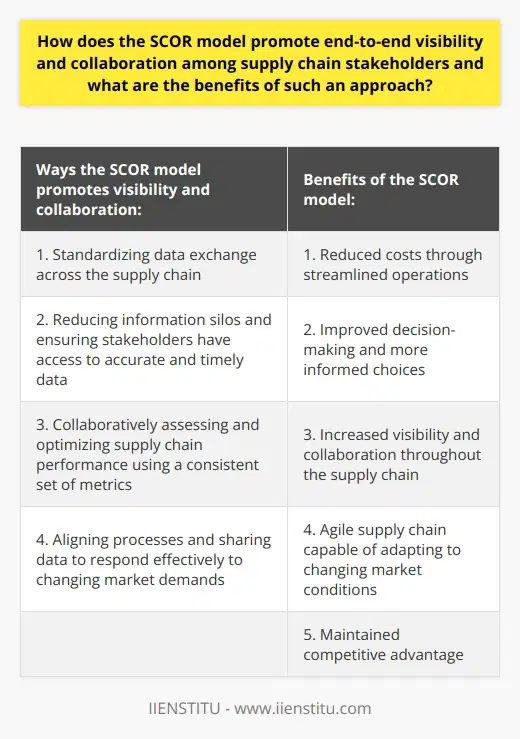
Can the SCOR model be applied to complex, global supply chains, and if so, what are some challenges and considerations for its implementation across multiple regions and industries?
Applicability to Complex Global Supply Chains
The SCOR (Supply Chain Operations Reference) model can indeed be applied to complex, global supply chains as it provides a comprehensive framework for managing and optimizing diverse supply chain challenges. The standardized performance measures, processes, and best practices prescribed by SCOR help businesses identify bottlenecks and inefficiencies across regions and industries.
Cross-Regional Challenges
The primary hurdles in implementing the SCOR model in multinational supply chains stem from the cultural, regulatory, and infrastructural differences present across multiple regions. Adapting the SCOR model in cross-cultural contexts requires sensitivity to regional nuances and significant input from local stakeholders.
Regulatory Difficulties
Supply chain operations across different countries often face stringent regulations and compliance requirements. Implementing the SCOR model in such contexts may necessitate changes or adaptations to ensure alignment with regional laws and industry standards. Overcoming these obstacles requires close collaboration between supply chain partners and a deep understanding of regional legal guidelines.
Infrastructure and Integration
Diverse infrastructures, technology systems, and standards can pose significant challenges when adopting the SCOR model in global supply chains. Seamless integration of SCOR processes across varying technology platforms, systems, and data formats must be achieved to reap the benefits of the model. Organizations must adopt agile methodologies, invest in upskilling their workforce, and align their technology infrastructure with SCOR requirements.
Tailoring to Industry Needs
As the SCOR model is designed to be applicable to various industries, organizations must carefully tailor the model's recommendations to suit their unique industry needs. This includes considering differences in lead times, manufacturing processes, customer demands, and geographical distribution. By customizing the model according to industry-specific requirements, companies can better leverage the SCOR model for supply chain optimization.
In conclusion, the SCOR model can be effectively applied to complex global supply chains, but organizations must address challenges and considerations related to regional differences, regulatory constraints, infrastructure integration, and industry-specific needs. By tackling these issues head-on, companies can successfully implement the SCOR model across multiple regions and industries, ultimately achieving supply chain optimization and improved performance.
